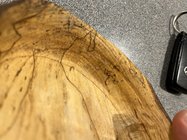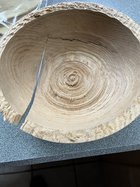Mr H said this much more succinctly, but from one newbie to another…
What has helped me judge bowl thickness is not judging it at all, but actually measuring as I go along, with a double-ended caliper. Cut, measure, cut, measure. For the bottom, I measure using a depth gauge. Another technique I sometime use is to drill a depth hole. When there’s no longer a hole, you are deep enough. The AWW journal has a couple of articles on making a depth gauge.
I struggle with getting a smooth interior as well. Sometimes if I get ridges with the 1/2” gouge, I’ll switch to the 3/8” and take lighter cuts. When that fails, I resort to a heavy round-nose scraper with a good burr, followed by 80-grit sandpaper. A light touch with the scraper in a shearing orientation will usually get it smooth enough without appreciable tear-out. Not ideal, but once it’s done, no one really cares how I got the bowl done (except me, or other woodturners).
I have a decent collection of DVDs and books, and there’s YouTube and all the resources AWW has to offer, especially the live demos. They have all been helpful, but nothing beats a hands-on class for learning this craft. I’ve only taken one half-day class so far, but that half-day was worth 10 times the amount spent watching demos. If there’s a local club nearby, join up. You might meet someone willing to be a mentor.
As you’ve discovered, a lot of things have to come together at once for a smooth interior: tool selection, tool geometry, tool sharpness, tool control through the entire cut, stance, body position, and more. Stuart Batty is only one of many, many pro woodturners that do a great bowl turning demo, but he sticks out in my mind as among the best. His videos are on Vimeo, as I recall. Richard Raffan, Glenn Lucas and Mike Mahoney also come to mind.
Good luck.
George
PS: I am a hobbyist woodturner, turning merely for my own enjoyment, and for friends and family.


 Newbie question: I’m learning bowl turning and keep having issues with the consistency of the interior surface of the bowl. In the best cases, my interior walls are a bit wavy and have some tool marks. In the worst case, I totally misjudged the thickness of a bowl wall and split the bowl. I imagine this is a common part of the learning curve, but I’m wondering if there is any advice about keeping the interior wall smoother. I suspect it has something to do with bevel contact as I make the curve. Thanks!
Newbie question: I’m learning bowl turning and keep having issues with the consistency of the interior surface of the bowl. In the best cases, my interior walls are a bit wavy and have some tool marks. In the worst case, I totally misjudged the thickness of a bowl wall and split the bowl. I imagine this is a common part of the learning curve, but I’m wondering if there is any advice about keeping the interior wall smoother. I suspect it has something to do with bevel contact as I make the curve. Thanks!
